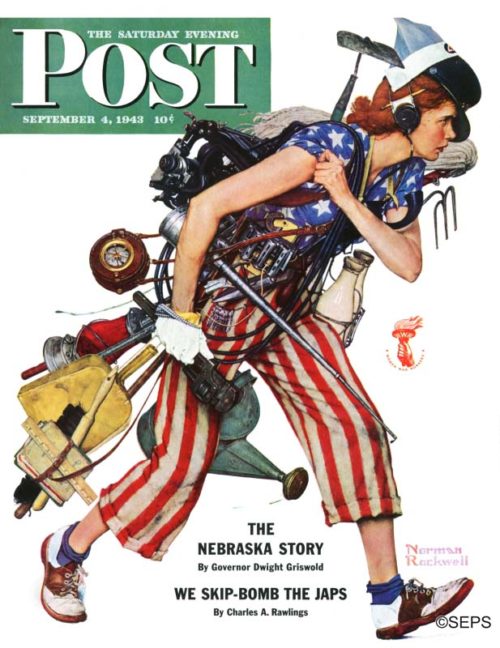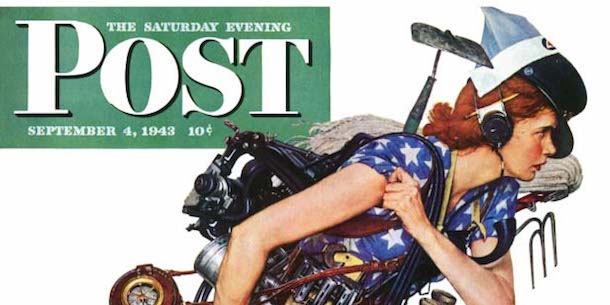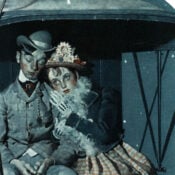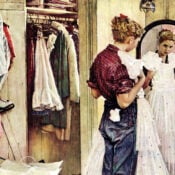
Norman Rockwell
September 4, 1943
In 1943, several major magazines agreed to salute the women war workers of America on their September covers. The Post gave the assignment to Rockwell, who’d already created an iconic tribute to women defense workers with Rosie the Riveter.
For this new cover, he wanted to acknowledge the wide range of jobs that 15 million women had taken up as men went off to war. The result was Rosie to the Rescue, which showed a woman bearing the symbols and tools of several trades hurrying off to her next job. The Post editors claimed 31 different occupations were represented on this cover. Some were jobs traditionally associated with women: cleaning, farming, nursing, and clerical work. Others, indicated by tools such as an electric cable and a monkey wrench, referred to industrial occupations that women were starting to enter in great number.
The cover not only acknowledges women war workers, it also recalls occupations of the 1940s that once employed thousands. Post readers of the day would have instantly recognized the bus-driver’s ticket punch, a taxi-driver’s change dispenser, a milkman’s bottle rack, a switchboard operator’s headset, and the blue cap of a train conductor. The railroad industry was also represented by the railroad section hand’s lantern, the locomotive engineer’s oil can, and that round object swinging on a shoulder strap — a clock used by night watchwomen in railway yards.
Here is what the Post editors had to say about this image in the “Keeping Posted” section of our September 4, 1943 issue:
At least thirty-one wartime occupations for women are suggested by Norman Rockwell’s remarkable Labor Day Post cover. Perhaps you can think of more. The thirty-one we counted, suggested by articles the young lady is carrying or wearing, are: boardinghouse manager and housekeeper (keys on ring); chambermaid, cleaner and household worker (dust pan and brush, mop); service superintendent (time clock); switchboard operator and telephone operator (earphone and mouthpiece); grocery-store woman and milk-truck driver (milk bottles); electrician for repair and maintenance of household appliances and furnishings (electric wire); plumber and garage mechanic (monkey wrench, small wrenches); seamstress (big scissors); typewriter-repair woman, stenographer, typist, editor and reporter (typewriter); baggage clerk (baggage checks); bus driver (puncher); conductor on railroad, trolley, bus (conductor’s cap); filling-station attendant and taxi driver (change holder); oiler on railroad (oil can); section hand (red lantern); bookkeeper (pencil over ear); farm worker (hoe and potato fork); truck farmer (watering can); teacher (schoolbooks and ruler); public health, hospital or industrial nurse (Nurses’ Aide cap). —“Keeping Posted: The Rockwell Cover,” September 4, 1943.
This article is featured in the July/August 2017 issue of The Saturday Evening Post. Subscribe to the magazine for more art, inspiring stories, fiction, humor, and features from our archives.
Become a Saturday Evening Post member and enjoy unlimited access. Subscribe now




Comments
YourRockwell Files “Stepping in for GIs 1945 really hit home for me. I was 11 at that time. My Dad worked at the Navy Shipyard in Bath Maine. I remember my brother and i hiding under the trees to see if a plane had American or Japaneses insignia on it before we dared to come out. Dad and Mama moved our family of 10 to Waldoboro, 30 miles away, but Dad still drove back and forth to the Bath Iron Works evey day, besides hand milking cows before and after. We knew a lady that starting working at the Shipyard and it seemed so weird to us. I rember Rosie the Riveter very well but this is the first time i remember seeing this wonderful picture of “Rosie to the rescue.” Thank you so much.